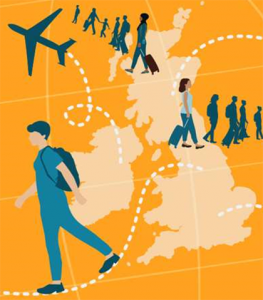UK sees biggest population decline since WWII
Britain’s population appears to have shrunk significantly during the COVID-19 pandemic with a new report suggesting about 1.3 million foreign-born people may have left the UK over the past 12 months.
The report by the Economic Statistics Centre of Excellence (ESCOE) echoes the finding of an earlier Oxford University report that found between about 400,000 and 600,000 people had departed.
 The ESCOE researchers said that “overall, instead of an increase of about 350,000 over the year, the total population falls by more than 1.3 million”.
The ESCOE researchers said that “overall, instead of an increase of about 350,000 over the year, the total population falls by more than 1.3 million”.
“While total population was almost flat in the late 1970s, if this is even close to being accurate, this is the largest fall in the UK resident population since World War II,” the researchers said.
The Oxford report said younger working-age people in their 20s and 30s had left in the greatest numbers, with many having been working in pubs, cafes and restaurants when COVID-19 struck.
But the UK does not collect complete data on who is arriving and leaving the country, so the data is speculative
Professor Madeleine Sumption, of University of Oxford’s Migration Observatory, says the total population has “probably” gone down.
Both her study and the research by ESCOE compared the period July to September 2019 with the same period in 2020.
The lowest estimates of the fall in the foreign-born population, are about 400,000 and the highest about 1.3 million.
The analysis by University of Oxford suggests that younger working-age people left in the greatest numbers.
And it’s possible that about a fifth of all foreign-born people in their 20s left the UK.
The studies suggest that London saw the biggest falls in the share of the foreign-born population.
This could be because London has so many jobs in hospitality, travel and tourism – sectors which were hit hard by the Covid-19 outbreak.
“The impact has been largest in London. While the published statistics say that the resident population has grown over the year, our estimate implies that the resident population of London might have fallen by nearly 700,000,” the ESCOE report said.
“Much of this may be temporary, if non-UK born people return to London after the pandemic; but it may not,” it said.
“Big shifts in population trends in London, driven by economic changes and events, are by no means historically unprecedented – Inner London’s population shrank by fully 20 per cent in the 1970s, so the recent picture of sustained growth driven by international migration is relatively recent. If this has now reversed, the medium to long-term implications for London will be profound
Prof Sumption agrees some of the change could be temporary and that large numbers of people may return, particularly if the UK economy picks up as the pandemic recedes.
But, “the longer that people stay away, the less likely it is that they will return,” she said.
A clearer population picture should emerge from the results of the census, but as it is conducted only every ten years and it won’t tell reveal changes between 2019 and 2020.
Other data from tax records, pensions and visas may help the ONS and others to update their estimates. The ONS says that new figures will be published soon.
Read the reports here:
https://www.escoe.ac.uk/estimating-the-uk-population-during-the-pandemic/












